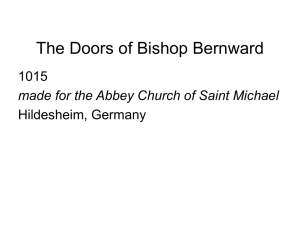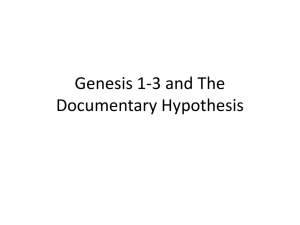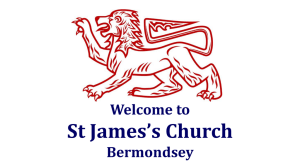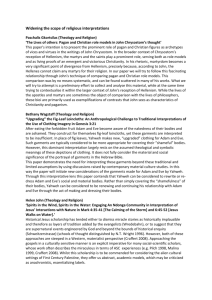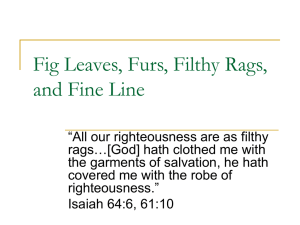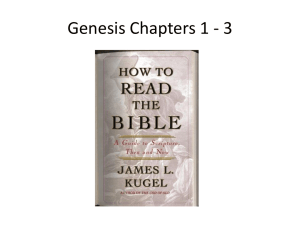RE 330 Eve, Interrupted
advertisement
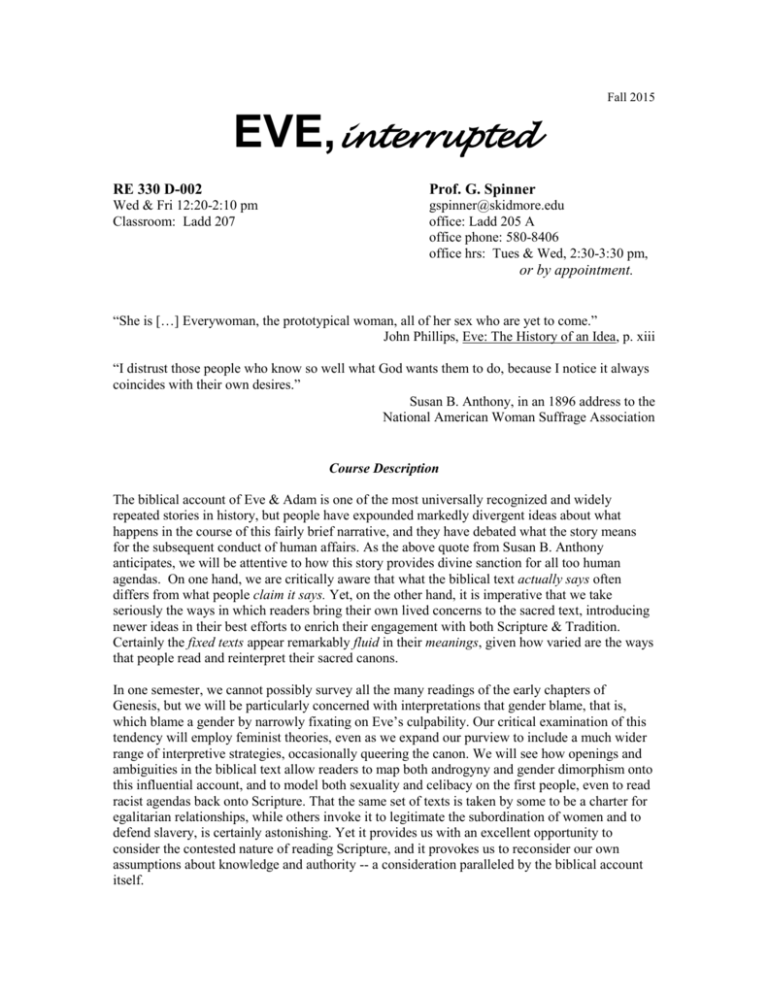
Fall 2015 EVE,interrupted RE 330 D-002 Prof. G. Spinner Wed & Fri 12:20-2:10 pm Classroom: Ladd 207 gspinner@skidmore.edu office: Ladd 205 A office phone: 580-8406 office hrs: Tues & Wed, 2:30-3:30 pm, or by appointment. “She is […] Everywoman, the prototypical woman, all of her sex who are yet to come.” John Phillips, Eve: The History of an Idea, p. xiii “I distrust those people who know so well what God wants them to do, because I notice it always coincides with their own desires.” Susan B. Anthony, in an 1896 address to the National American Woman Suffrage Association Course Description The biblical account of Eve & Adam is one of the most universally recognized and widely repeated stories in history, but people have expounded markedly divergent ideas about what happens in the course of this fairly brief narrative, and they have debated what the story means for the subsequent conduct of human affairs. As the above quote from Susan B. Anthony anticipates, we will be attentive to how this story provides divine sanction for all too human agendas. On one hand, we are critically aware that what the biblical text actually says often differs from what people claim it says. Yet, on the other hand, it is imperative that we take seriously the ways in which readers bring their own lived concerns to the sacred text, introducing newer ideas in their best efforts to enrich their engagement with both Scripture & Tradition. Certainly the fixed texts appear remarkably fluid in their meanings, given how varied are the ways that people read and reinterpret their sacred canons. In one semester, we cannot possibly survey all the many readings of the early chapters of Genesis, but we will be particularly concerned with interpretations that gender blame, that is, which blame a gender by narrowly fixating on Eve’s culpability. Our critical examination of this tendency will employ feminist theories, even as we expand our purview to include a much wider range of interpretive strategies, occasionally queering the canon. We will see how openings and ambiguities in the biblical text allow readers to map both androgyny and gender dimorphism onto this influential account, and to model both sexuality and celibacy on the first people, even to read racist agendas back onto Scripture. That the same set of texts is taken by some to be a charter for egalitarian relationships, while others invoke it to legitimate the subordination of women and to defend slavery, is certainly astonishing. Yet it provides us with an excellent opportunity to consider the contested nature of reading Scripture, and it provokes us to reconsider our own assumptions about knowledge and authority -- a consideration paralleled by the biblical account itself. Learning Goals By taking this course, students will: (i.) examine biblical texts carefully, distinguishing what the texts actually say from what commentators insist they must say; (ii.) familiarize themselves with the history of scriptural interpretation, particularly the rabbinic and patristic sources that come to define the Jewish and Christian traditions; (iii.) scrutinize some modern and contemporary applications of those interpretations; (iv.) think critically about gender and race; and (iv.) consider the contested nature of reading Scripture. Course Materials There are two required books: Eve and Adam: Jewish, Christian, and Muslim Readings on Genesis and Gender, edited by Kristen E. Kvam, Linda S. Schearing & Valarie H. Ziegler; and Gary Anderson, Genesis of Perfection: Adam and Eve in Jewish and Christian Imagination. Other required readings will be distributed as a Course Reader. A recommended text is HarperCollins Study Bible (NRSV with Apocrypha). You will occasionally need to consult a Bible, so I ordered one in case you do not have one handy. As the cornerstone of both Jewish and Christian spirituality, as well as the great touchstone of Western literature, it is not a bad idea to have a copy handy. This revised and updated edition provides an accurate English translation, along with scholarly introductions and notations that should help you gain a purchase on the material. Welcome to a Seminar This course is conducted as a seminar, so let me address my general expectations for such a format: students will take the lead in asking questions, proposing answers and steering discussions. Our term “seminar,” indicating an intimate class focused on close readings and collaborative efforts, comes from the Latin seminarium, literally a “seed-plot,” a small area to plant ideas and watch them grow, the place where one nurtures intellectual habits of thought. The analogy of academic development to gardening may seem quaint, but those familiar with gardening will recognize that the analogy is demanding real commitment and critical rigor, just as gardening requires regular attention and honest labor. The seminar format means that you must engage each other, and not just the instructor; it means that it is you who will be doing the talking, by asking each other questions and working through the answers together. Seminars are always reading intensive, but as a course about how people read and reread the opening chapters of Genesis, reading here becomes our central concern and our own critical practice. I believe you will find this subject very rewarding, and even enjoyable -- just never easy. It requires your sustained effort and the mutual support of your classmates, and I hope that you are as excited as I am by the challenges it poses. Course Requirements Your grade consists of the following components: Participation Preparing Questions Midterm Team Presentation Individual Research/Creative Project _________________________________ 10 % 5% 30 % 25 % 30 % Total 100 % A few words are in order, at the outset, about some of these components: Attendance is mandatory: you will come to each and every class. If you are too sick to attend, or if an emergency arises, then please contact me as soon as possible. While participation is contingent upon attendance, it involves much more than just showing up. Participation requires active engagement: you must have done the reading and be prepared to discuss it. You should have your own questions prepared, and you should be game for answering the questions that others pose. Our goal is focused conversation: it involves talking with and listening to others, rather than sitting quietly by (no matter how deep in thought you are). Preparing Questions: for each class you should prepare a minimum of two questions, along with your own (tentative) answers, that you could ask the other students with the express purpose of facilitating classroom discussion. You are not trying to stump your classmates; rather you are trying to direct the conversation to some of the more salient points from the readings. Your questions should therefore be carefully chosen and thoughtfully worded. I will collect your questions at the end of each class session, and will only accept them in class on the day they were due. While I won’t be assigning grades (or returning them), I will be looking over your questions to see what you have been thinking about and to assess your level of engagement. The midterm will be a take-home essay, and must be submitted in hard-copy form. Closer to the time of the assignment, I will spell out my expectations as to what makes for a good essay. Late work will be marked down. I will deduct half a letter grade for each day any assignment is late. While due dates are firm, the instructor is not inflexible. It is, however, incumbent on you to explain to me why you deserve an extension. And here’s some good advice: one asks for an extension before a deadline is missed. Team Presentations involve leading a class discussion in the latter half of the semester. I will say more about how that will work, and how your individual projects will be structured, soon enough. Do note that this is a 4 credit hour class, and thus my expectations for your time and effort, both inside and outside of the classroom, are set accordingly. Academic Integrity I have zero tolerance for any form of intellectual dishonesty. Make sure your work is entirely your own, and that you give credit to any ideas or formulations that originate with others. Plagiarism is a serious violation of academic integrity, whether fully intentional or not. Recall that Skidmore’s Honor Code does not accept ignorance or error as adequate defense for violations. To learn more about the Honor Code and related matters, please consult: http://cms.skidmore.edu/advising/integrity/index.cfm. Suspected infractions of this policy will be reported to the Office of Academic Advising. Student Disabilities I am happy to make reasonable accommodations for students with disabilities. If you believe you will need it, then you must formally request academic accommodation from Meg Hegener, Coordinator for Students with Disabilities, and provide documentation verifying your disability. For further information, please call 580-8150, or stop by the office of Student Academic Services in the lower level of Starbuck Center. Partners in Learning To my mind, a syllabus establishes a kind of social contract, in which you and I agree to create a stimulating and supportive learning environment. I hope that we find a mutual interest in critical inquiry, share a passion for increased understanding, and have a good time while we are at it. You may always ask questions; I will not mind if you ask me to repeat something or to clarify a point. The most expedient way to contact me is by e-mail. And please feel free to come by my office if something is on your mind. I trust that with this syllabus I have made clear my expectations, and that if I have not, you will call me to account. I also ask that you make your own expectations clear to me, so that we can best achieve a partnership in learning. I look forward to an exciting semester of working together. Dr. Spinner EVE,interrupted CLASS & READING SCHEDULE Sept 9. Introductions: syllabus, classmates, instructor. Sept 11. Bible, I. A World So Good, It Was Created Twice. Reading 1. Sept 16. Bible, II. Forbidden Fruits & Feminists. Reading 2. Sept 18. Bible, III. Androgynes & Queer Theorists. Reading 3. Sept 23. No class: Yom Kippur. Sept 25. (re)Reading/(re)Writing Eden. Reading 4. Sept 30. Midrash, I. Giving a Fig. Reading 5. Oct 2. Midrash, II. Husbands & Pandoras. Reading 6. Oct 7. New Testament, New Adam. Reading 7. Oct 9. Christians. Reading 8. Oct 14. Gnostics. Reading 9. Oct 16. Satan, the Old Foe. Reading 10. Oct 21. Mary, the New Eve. Reading 11. Oct 23. Bodies of Light, Garments of Skin. Reading 12. Oct 28. Sinners & Penitents. Reading 13. Oct 30. The Demonic Feminine, I. Lillith. Reading 14. Nov 4. The Demonic Feminine, II. Witches. Reading 15. Nov 6. Abolition Debates: Wives & Slaves. Reading 16. Nov 11. Return to Eden, I. The Shakers. Reading 17. Nov 13. Return to Eden, II. The Oneida Community. Reading 18. Nov 18. Reading Race, I. Pre-Adamite Theory. Reading 19. Nov 20. No class: American Academy of Religion. Nov 25 & 27. No classes held this week: Thanksgiving Break. Dec 2. Dec 4. Reading Race, II. The Serpent Seed. Reading 20. Wives & Mothers, I. Quiverfull. Reading 21. Dec 9. Wives & Mothers, II. Pious Bodies. Reading 22. Dec 11. Conclusions. EVE,interrupted Readings Unless otherwise noted, the assigned pages refer to the Eve and Adam reader. Reading 1. Gen 1:1-2:25. Read the General Introduction, pp. 1-10. For some context on the biblical accounts, read pp. 15-21. Then read both the texts of and commentaries on Genesis chs. 1-2 on pp. 22-top 31. Fill out the worksheet as you read. Reading 2. Gen 3:1-4:2 and 5:1-5. Read both the texts of and commentaries on Gen 3-5, pp. 31-39. Also read both essays by Trible: “Eve and Adam,” pp. 431-438, and “Not a Jot, Not a Tittle,” pp. 439-444. Reading 3. Plato, Symposium (CR). Stone, “The Garden of Eden and The Heterosexual Contract” in Bodily Citations, edited by Armour and St. Ville, which you can access as an e-book through Scribner. Reading 4. We will read selectively in ch. 2 (Jewish Postbiblical Interpretations). Focus on three texts: Sirach (pp. 48-50), Jubilees (pp. 50-54), and Philo (pp.6466; cf. the discussion of Philo earlier, on pp. 41-42). Reading 5. We begin reading ch. 3 (Rabbinic Interpretations) For context, read pp. 6976, then read the midrashic & talmudic excerpts, pp. 77-very top 87. Selections from Blidstein, In The Rabbis’ Garden (CR). Reading 6. Read more midrashic & talmudic excerpts, pp.87- 100. Compare Hesiod’s two versions of the story of Pandora (CR). Further selections from Blidstein, In The Rabbis’ Garden (CR). Reading 7. We begin reading ch. 4 (Early Christian Interpretations). For context, read pp. 108-mid 110 and mid 112-114. Carefully inspect the New Testament passages on pp. 117-119, and also look up Romans 5:12-21. Read Bassler, “Deception in the Garden,” pp. 444-455. Reading 8. The latter part of ch. 4 samples Church Fathers, whom we will read selectively: Tertullian (pp. 131-132), Origen (pp. 133-135), Chrysostom (pp.141147), and Augustine (pp. 147-154). Read Al Hartley, Adam & Eve (Spire Christian Comics, 1975), which can be accessed through Blackboard, approaching Hartley’s work as a theological document. EVE,interrupted Readings, continued Reading 9. From Eve & Adam, read the section on The Gospel of Philip (pp.121-123). From the Course Reader, read The Revelation of Adam and Seal, “Gnostic Eve.” Reading 10. Begin reading Anderson, Genesis of Perfection, by reviewing the three theses before the title page. Read the introduction and ch. 1 (pp. 1-41). If you like, you can skim the Milton passages in Eve & Adam, pp. 288-304. Reading 11. Anderson, chs. 2-4 (pp. 43-97). Reading 12. Anderson, chs. 5-6 (pp.99-134). Reading 13. Anderson, chs. 7-8 (pp. 135-176). Read Appendixes C-D (Life of Adam & Eve; Gospel of Nicodemus), pp. 219-230. Compare the selections from Kummer, Ladies in Hades (CR). Reading 14. For context, read pp.161-165. Read pp. lower 206 (from “Sammael and Eve”)-top 208. Read only the following excerpts from the Zohar: Bereshit 35a, 36b, 49b & 55b, pp. 222-225; supplement these with Zoharic materials presented by Tishby, The Wisdom of the Zohar (CR). For background on Lilith, review Scholem (CR). Carefully peruse the story from The Alphabet of Ben Sira, part v, skimming episodes vi-ix (CR). For a contemporary reappropriation of Lilith, you can skim Plaskow (Eve & Adam, pp. 421-430). Reading 15. For context, read pp. mid 169-mid 172. Read selections from the Malleus Maleficarum, pp. 241-248. Read Stratton (CR), skimming the sections on ancient terminology. Reading 16. We begin ch. 7 (“Social Applications in the United States”). For context, read pp. mid 309–top 315 and mid 323-324. Read Fred A. Ross (pp. 324-326), Samuel B. How (pp. 326–332), Rev. Charles Elliott (pp. 333-336) and Sarah Grimke (pp. 340-345). EVE,interrupted Readings, concluded Reading 17. Focusing on the Shakers: for context, read pp. 315-319. Read selections from Frederick Evans and Paulina Bates, pp. 356-363. Plus: TBA. Reading 18. Focusing on the Oneida Community: read excerpts from Noyes, History of American Socialisms, pp. 363-367. Plus: TBA. Reading 19. Focusing on Pre-Adamite Theory: read pp. 483-mid 491 (introduction to the Appendix, and selection from D. G. Phillips). Read excerpts from Charles Carroll, The Negro a Beast, in CR. Possibly more TBA. Reading 20. Focusing on the Christian Identity Movement: read Wesley Swift (pp. 496-499) and Richard Butler (pp. 499-502). Read excerpts from Barkun, Religion and the Racist Right, in CR. Reading 21. Read excerpts from Joyce, Quiverfull, in CR. Possibly more TBA. Reading 22. Chava Weissler, “Mitzvot Built into the Body,” and Susan Martha Kahn, “Rabbis and Reproduction: The Uses of New Reproductive Technologies among Ultraorthdox Jews in Israel,” both in CR.

